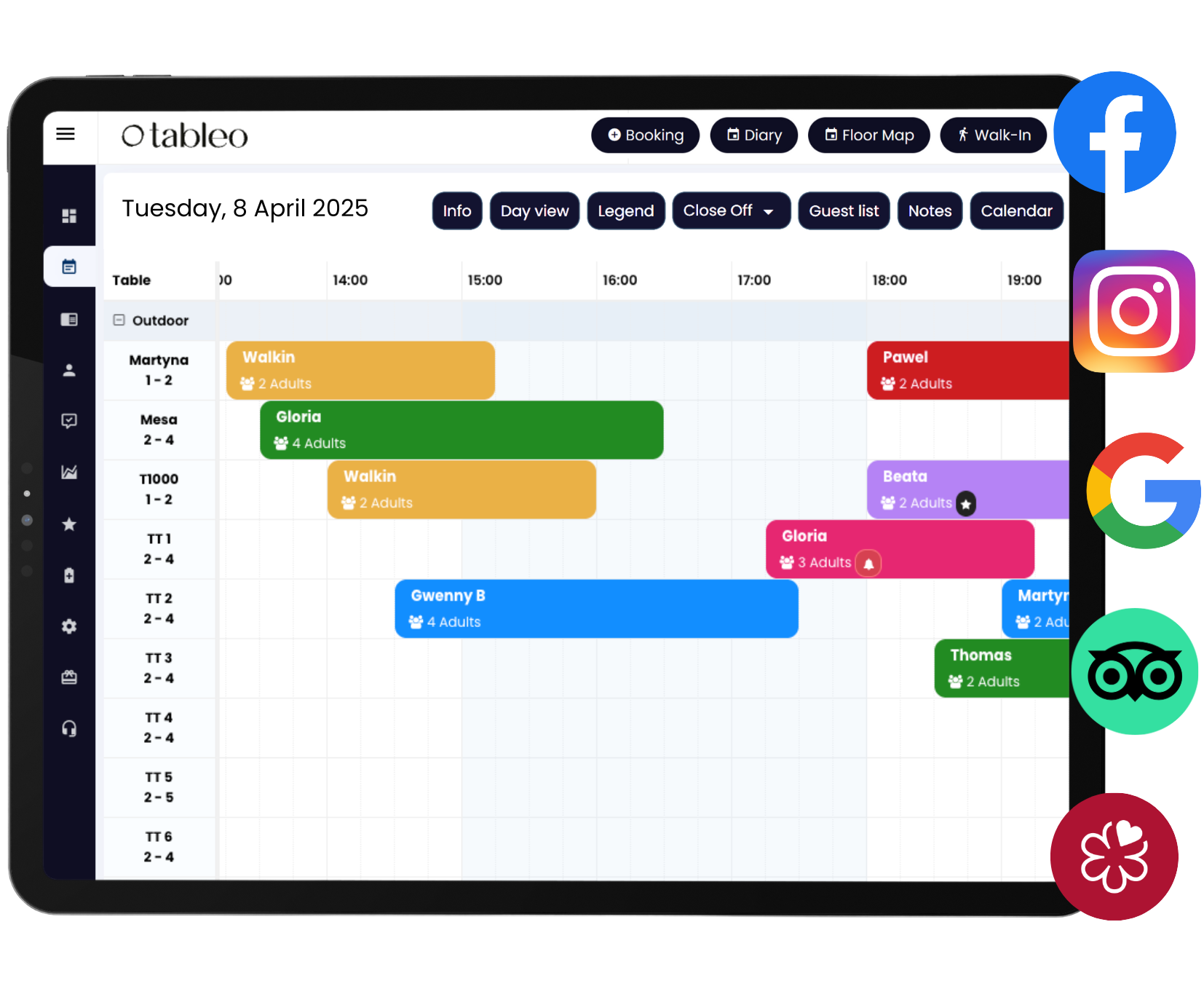Restaurant owners are feeling the heat as financial trouble looms over the industry. On the surface, a busy dining room might suggest prosperity. Yet, an estimated 450 restaurant bankruptcies are projected for 2025, double the number from just two years ago. That number is only the beginning. The real threat comes from hidden vulnerabilities like operational mishaps and technology failures that can collapse a business almost overnight. Most guides focus on obvious risks, but the survival of your restaurant depends on what you do when disaster strikes from the least expected places.
Table of Contents
- Identifying Common Crises In Hospitality
- Building An Effective Crisis Management Plan
- Communication Tactics During Emergencies
- Post-Crisis Recovery And Reputation Repair
Quick summary
| Takeaway | Explanation |
|---|---|
| Understanding Financial Vulnerabilities | Anticipating financial crises is crucial; with an estimated 450 restaurant bankruptcies projected for 2025, owners must monitor cash flow, debt levels, and profit margins closely. |
| Establishing a Crisis Response Team | Creating a dedicated crisis management team with defined roles across legal, operations, HR and marketing ensures rapid response capabilities during emergencies. |
| Implementing Comprehensive Communication Strategies | Developing both internal and external communication plans, including using multiple channels and predefined templates, enhances readiness and maintains trust during crises. |
| Conducting Thorough Post-Crisis Assessments | Post-crisis recovery should involve a detailed assessment of financial, operational, reputational, and staff impacts to implement targeted improvements and restore trust. |
| Building Long-Term Recovery Frameworks | Authentic communication and transparency during recovery are vital; sharing improvement plans and actively engaging with customers can foster loyalty and enhance reputation. |
Identifying common crises in hospitality
Restaurant crisis management begins with understanding the potential risks that can disrupt operations and threaten business stability. The hospitality industry faces a complex landscape of challenges that require strategic preparation and rapid response mechanisms.
Financial vulnerabilities in restaurant operations
Financial crises represent a significant threat to restaurant sustainability. Research from ABN AMRO Bank projects a stark warning for the restaurant sector, with an anticipated 450 restaurant bankruptcies in 2025—double the number recorded in 2023. These financial pressures stem from multiple interconnected factors: escalating operational costs, inflationary impacts on ingredient prices, rising wage requirements, and unpredictable market dynamics.
The economic landscape demands restaurants maintain exceptional financial resilience. Key financial crisis indicators include:
- Negative Cash Flow: Consistent monthly losses
- High Debt Levels: Unsustainable borrowing
- Reduced Profit Margins: Less than 3-5% net profit
Operational and reputational risks
Operational disruptions can rapidly transform into full-scale crises. According to industry analysis, the most prevalent challenges include foodborne illness outbreaks, staff controversies, viral social media incidents, service failures, and on-premise conflicts. Each scenario requires a nuanced, rapid response strategy to mitigate potential reputational damage.
The COVID-19 pandemic starkly illustrated the restaurant industry’s vulnerability. Research from the St Louis Restaurant Review documented over 110,000 restaurant closures in the United States by 2021, underscoring the critical need for adaptive crisis management protocols.
Technology and human resource challenges
Modern restaurant crisis management extends beyond traditional operational concerns. Emerging challenges include technological disruptions, cybersecurity threats, and complex human resource management. Staff shortages, skills gaps, and workplace culture issues can precipitate significant operational challenges.
Restaurant owners must develop comprehensive crisis response frameworks that address:
- Technological Preparedness: Backup systems and digital resilience
- Staff Training: Crisis communication and response protocols
- Adaptive Management: Flexible operational strategies
By recognizing these potential crisis points, restaurant owners and managers can proactively develop robust strategies for navigating unexpected challenges. Understanding these risks is the first critical step in building a resilient, adaptive hospitality business capable of weathering unpredictable market conditions.
Building an effective crisis management plan
Developing a comprehensive crisis management plan is crucial for restaurant survival in an increasingly unpredictable business environment. A strategic approach transforms potential disasters into manageable challenges, protecting both operational integrity and business reputation.
Establishing a dedicated crisis response team
Research from industry experts highlights the critical importance of creating a dedicated crisis management team with clearly defined roles. This team should include representatives from key organizational departments:
- Legal Representative: Managing potential legal implications
- Operations Manager: Coordinating immediate response strategies
- Human Resources Lead: Supporting staff and managing internal communication
- Marketing/PR Specialist: Managing external communication and brand reputation
Each team member must understand their specific responsibilities and have the authority to make rapid decisions during crisis scenarios. Regular training and simulation exercises ensure the team remains prepared and responsive.
Comprehensive documentation and preparedness
Guidance from TRN USA emphasizes that an effective crisis management plan must be a dynamic, living document. Key components should include:
- Detailed risk assessment protocols
- Clear inventory action plans
- Employee support systems
- Vendor coordination mechanisms
- Robust communication channels
The plan must be regularly updated to reflect changing business landscapes, emerging technologies, and potential new risk factors. Digital documentation allows for easier updates and accessibility across the organization.
Communication and implementation strategies
Successful crisis management hinges on clear, transparent communication. Our comprehensive guide on restaurant crisis protocols recommends developing multi-channel communication strategies that encompass internal staff communication, customer messaging, and potential media interactions.
Implementation requires more than just documentation. Restaurant owners must:
Conduct periodic emergency preparedness drills
Ensure all staff understand their roles during potential crises
Develop clear evacuation procedures
Create templated communication responses for various scenarios
Establish backup communication systems
By treating the crisis management plan as a strategic asset rather than a compliance document, restaurants can transform potential vulnerabilities into opportunities for demonstrating resilience and professional adaptability. Regular review, training, and a proactive mindset are the cornerstones of effective crisis preparedness in the modern hospitality landscape.
Communication tactics during emergencies
Effective communication during restaurant emergencies can mean the difference between business survival and catastrophic reputation damage. Swift, clear, and strategic communication across multiple channels becomes the lifeline that connects restaurant management, staff, and customers during high-stress scenarios.
Internal communication strategies
Research from OneTeam emphasizes the critical importance of establishing robust internal communication protocols. Emergency notification systems must be designed to rapidly disseminate information to employees, ensuring everyone understands their roles and responsibilities during a crisis.
Key internal communication tactics include:
- Designated Communication Team: Assign specific staff members responsible for information distribution
- Multi-Channel Notification Systems: Utilize SMS, email, and digital platforms for redundant communication
- Predefined Communication Templates: Prepare standardized messages for different emergency scenarios
- Regular Training and Simulation: Conduct periodic drills to test communication effectiveness
The goal is to create a communication infrastructure that minimizes confusion and enables rapid, coordinated responses across the entire organization.
External communication and customer engagement
Guidance from TRN USA highlights the significance of maintaining consistent communication with customers during emergencies. Transparent, timely messaging helps preserve brand reputation and customer trust.
External communication strategies should encompass:
- Social media platform management
- Email communication lists
- Website emergency notifications
- Physical signage at restaurant locations
- release protocols
By developing comprehensive crisis communication frameworks, restaurants can transform potential communication challenges into opportunities for demonstrating professionalism and customer care.
Digital and traditional communication channels
Modern crisis communication requires a sophisticated, multi-channel approach that integrates digital platforms with traditional communication methods. Restaurant managers must create a communication ecosystem that ensures message consistency and accessibility.
Effective digital communication channels include:
- Social Media Platforms: Real-time updates and customer engagement
- Emergency Hotlines: Dedicated phone support for immediate inquiries
- Mobile Apps: Push notifications for registered customers
- Website Banners: Prominent emergency information display
Traditional channels like telephone communication, physical signage, and local media relationships remain crucial for reaching diverse customer demographics.
Successful emergency communication is not about perfection but about demonstrating genuine care, transparency, and commitment to customer and staff safety. By investing in robust communication strategies, restaurants can navigate complex emergency scenarios with confidence and professionalism.
Post-Crisis recovery and reputation repair
Post-crisis recovery represents a critical phase where restaurants can transform potential reputational damage into an opportunity for demonstrating resilience, transparency, and commitment to improvement. The strategic approach to reputation repair can determine whether a business survives or succumbs to the long-term consequences of a crisis.
Comprehensive damage assessment
Research from the National Restaurant Association emphasizes the importance of proactive crisis management teams in guiding operational recovery. The initial recovery phase requires a thorough and objective assessment of the crisis impact across multiple dimensions:
- Financial Damage: Quantifying direct and indirect economic losses
- Operational Disruptions: Identifying systemic vulnerabilities
- Reputational Impact: Measuring customer trust and brand perception
- Staff Morale: Evaluating internal psychological and professional consequences
This comprehensive evaluation provides a strategic foundation for targeted recovery efforts, enabling restaurant owners to address root causes and implement meaningful improvements.
Strategic external collaboration
According to international crisis management guidelines, successful post-crisis recovery demands collaboration with external specialists. These experts bring objective perspectives and specialized skills to navigate complex reputation repair challenges.
Key external collaboration strategies include:
- Engaging communications advisers
- Consulting reputation management specialists
- Working with technical remediation experts
- Collaborating with legal professionals
External perspectives help restaurants develop nuanced, comprehensive recovery strategies that extend beyond immediate crisis management.
Transparent communication and rebuilding trust
Industry experts from Global Food Insights highlight that rebuilding customer trust requires authentic, transparent communication. The recovery narrative must demonstrate genuine accountability, concrete improvement plans, and a commitment to preventing future incidents.
Effective trust reconstruction involves:
- Public Acknowledgment: Openly addressing the crisis and its impact
- Detailed Improvement Plans: Sharing specific corrective actions
- Ongoing Transparency: Regular updates on progress and implementation
- Customer Engagement: Actively soliciting feedback and demonstrating responsiveness
By developing comprehensive recovery frameworks, restaurants can transform crisis experiences into opportunities for organizational growth and enhanced customer loyalty.
Successful post-crisis recovery is not about erasing the past but about creating a compelling narrative of resilience, learning, and continuous improvement. Restaurants that approach recovery with strategic intent, emotional intelligence, and genuine commitment can emerge stronger, more adaptable, and more trusted by their customers.
Future-Proof your restaurant operations with real-time crisis solutions
When threats like sudden cancellations, operational disruptions, and unpredictable guest behaviour put your business on the line, proactive tools are your frontline defence. This guide laid out the harsh reality: even thriving restaurants can be vulnerable to crises such as overbooking, excessive no-shows, or chaos in guest management. As a restaurateur striving to maintain control and restore confidence, you know that effective crisis management starts with technology that anticipates problems before they escalate.
Why wait for disruption to cost you customers and revenue? Give your team the right tools to react instantly and keep operations flowing no matter what challenge arrives. Tableo’s intelligent reservation management platform delivers automated booking control, guest tracking, and advanced messaging features—all designed to help you handle emergencies with calm and professionalism. Bookings, reminders and analytics are seamlessly unified, lowering risk and rebuilding customer trust. Experience how Tableo lets you act before a crisis hits. Discover the full suite of features and see how you can safeguard your business today.
Frequently Asked Questions
Restaurants often face financial vulnerabilities, operational disruptions such as foodborne illness outbreaks, and reputational risks from social media incidents or service failures. Technology and human resource challenges can also pose significant threats.
To prepare a crisis management plan, establish a dedicated crisis response team, conduct comprehensive documentation of risks and protocols, and develop communication strategies for both internal and external audiences. Regularly update and practice the plan to ensure readiness.
Effective communication during a crisis helps maintain transparency and customer trust. It ensures that employees understand their roles and responsibilities while keeping customers informed of any changes or issues, which can mitigate potential reputation damage.
Post-crisis recovery involves conducting a thorough damage assessment, collaborating with external specialists for strategic guidance, and engaging in transparent communication with customers about improvements being made. This approach can help rebuild trust and loyalty.

Stephanie Paris
Gen-Z marketing coordinator bringing fresh energy to web and graphic design, with a weekend habit of chasing adventure.

Stephanie Paris
Gen-Z marketing coordinator bringing fresh energy to web and graphic design, with a weekend habit of chasing adventure.













